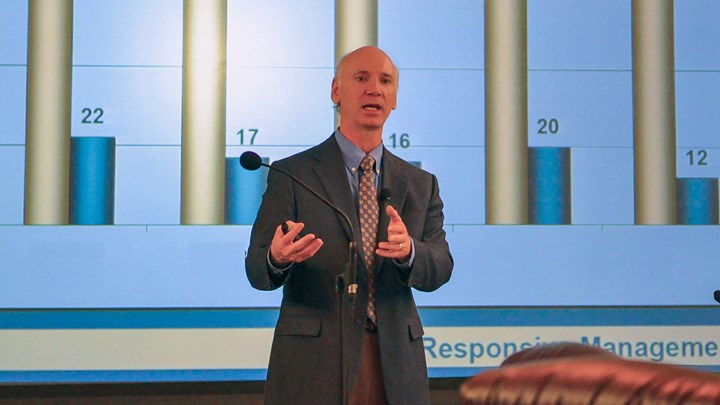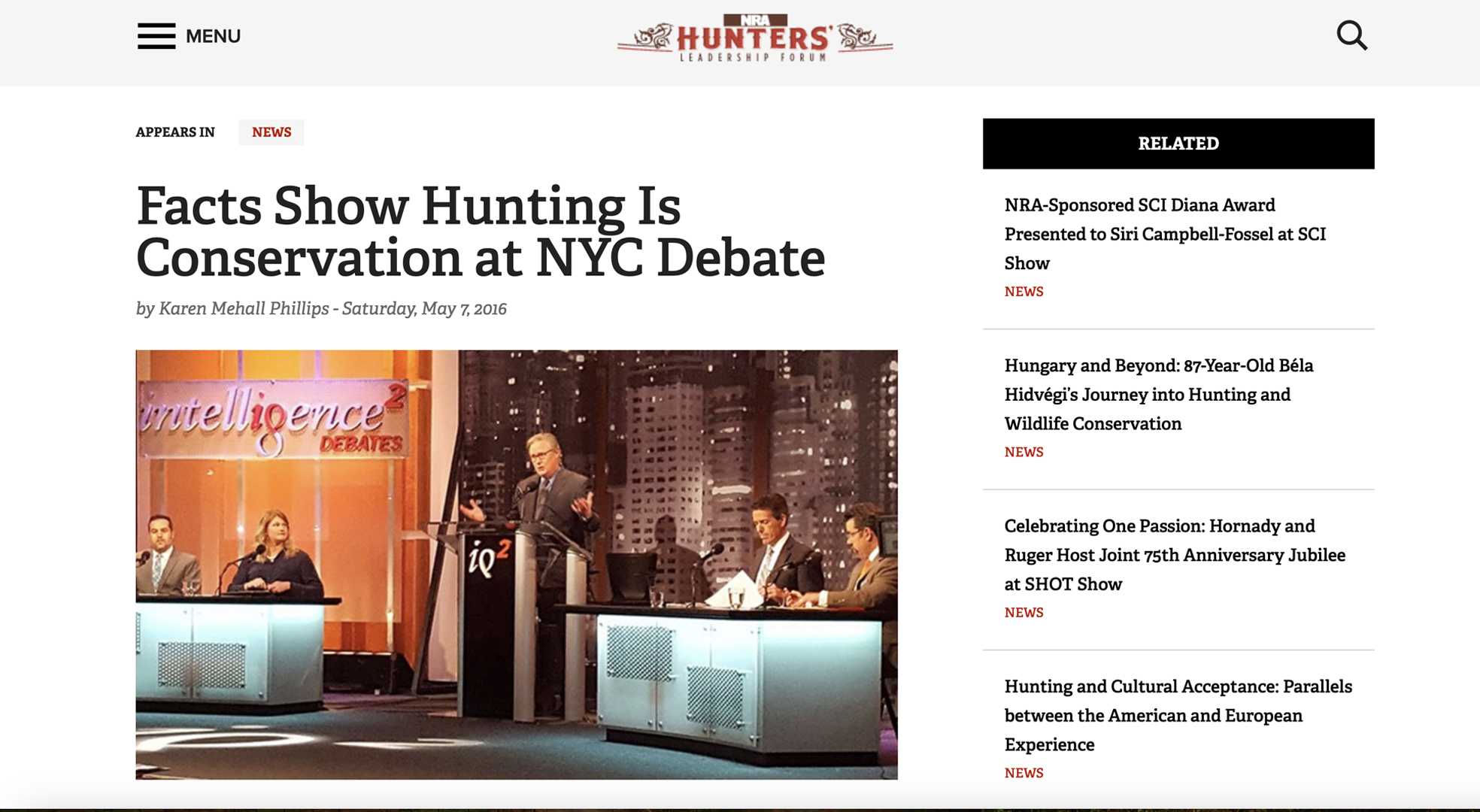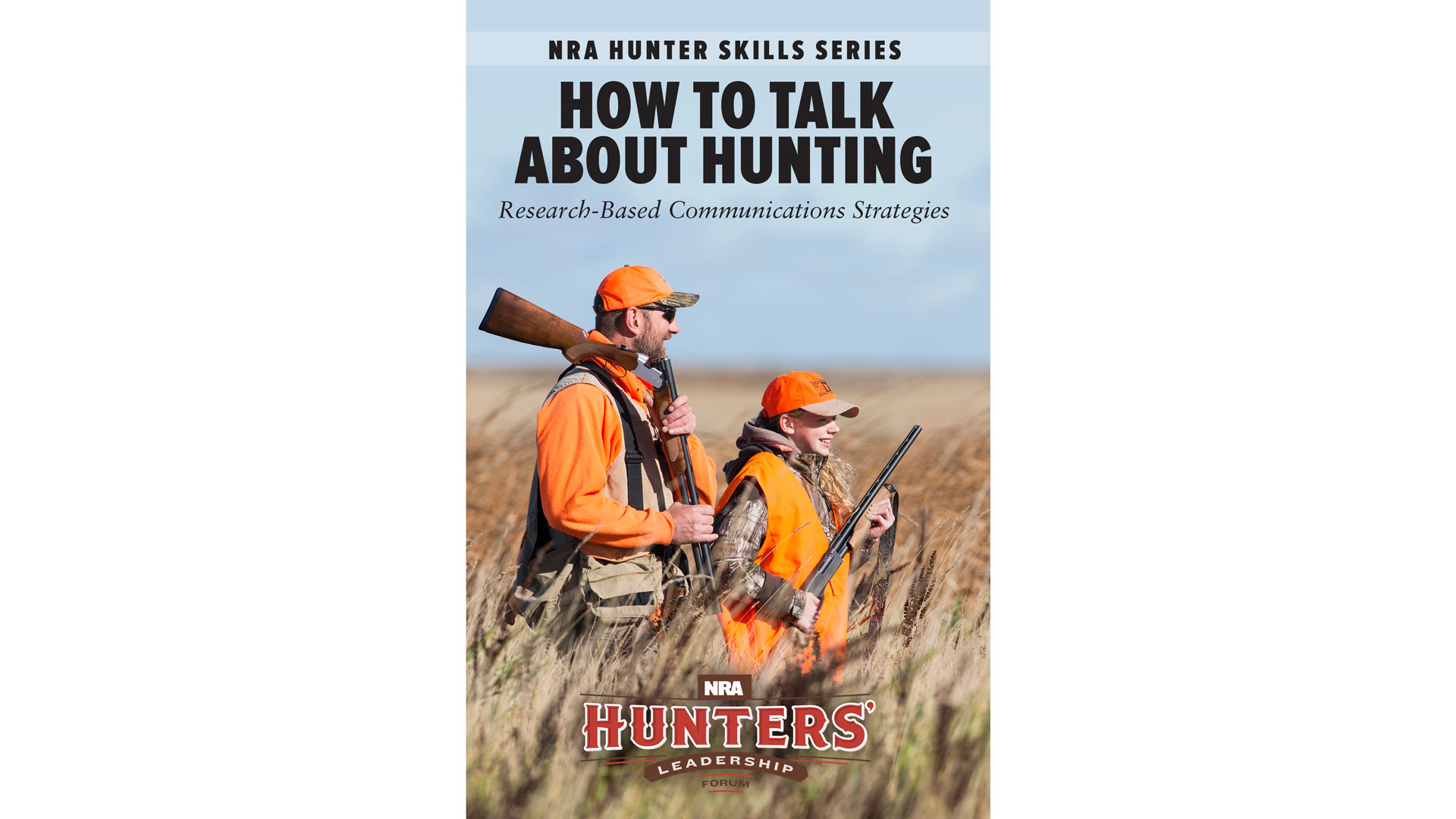
by Brian McCombie - Monday, February 12, 2024

It was late 2016 and Mark Damian Duda, the executive director of Responsive Management, a research firm specializing in natural resource and outdoor recreation issues, was hard at work conducting a major study for the National Rifle Association on animal rights and animal welfare issues, including their potential impacts on hunting and the future of wildlife conservation in the United States. Funded by the NRA Hunters’ Leadership Forum (HLF), the research included numerous focus groups across the nation and a large-scale scientific survey addressing not only animal rights and animal welfare issues but also public attitudes toward wildlife, hunters, hunting and conservation.
“Public opinion on hunting goes beyond how people feel about the activity itself,” said Duda. “The fact is, hunting is inextricably linked to the conservation of wildlife in the United States because hunters contribute significantly to habitat management, species recovery and other aspects of conservation through their purchases of licenses. In addition to licenses, hunters help pay for conservation when they buy firearms and ammunition, both of which are subject to a federal excise tax whose revenues are apportioned to the state fish and wildlife agencies.”
Duda continued: “This funding structure is what many refer to as a ‘user-pays, public-benefits’ system. Hunters help shoulder the funding burden, but everyone—hunters and non-hunters alike—benefits from the result of dedicated conservation efforts, which is healthy wildlife populations that will be around for future generations.”
Leading into the animal rights/animal welfare project, in May 2016, the group Intelligence Squared, a noted forum for agenda-setting debates and discussions, held a live public debate in New York City on whether hunters conserve wildlife. Both the pro-hunting and anti-hunting sides of the argument were represented by two noted panelists, who stated and defended their positions. At the debate’s conclusion, the audience voted on the motion of whether hunters conserve wildlife. (As reported by the NRA HLF website, NRAHLF.org, those debating in support of hunting had an uphill battle, as the audience demographics of the urban location likely favored the anti-hunting position before the debate even began.)

“The pro-hunting side did a good job but did not have much research to go on,” Duda remembered. “The anti-hunting side presented lots of factually incorrect information, and a vote at the end of the debate showed that the audience concluded that hunters do not conserve wildlife, which couldn’t be more untrue.”
This very much concerned Duda, who grew up in a non-hunting family in Washington, D.C., and became a hunter as an adult after leading hundreds of studies on the link between hunting and conservation. In working to protect hunting, the public debate was on the NRA’s radar, too. The NRA had long been addressing the challenges of misinformation that distorts the role of hunting as a vital wildlife management tool and source of conservation funding. NRA HLF Communications Director Karen Mehall Phillips attended the NYC debate to represent the NRA and cover it for NRA Publications. Following the debate, the audience voted that hunters do not conserve wildlife—a vote that confirmed a growing sense within the NRA that, to a large extent, the future of hunting and wildlife conservation funding in the U.S. will depend on how the non-hunting public views hunting. The debate showed just how easily opinions can be swayed by exaggerations, falsehoods and emotional anti-hunting appeals.
With the debate underscoring the need for a nationwide study on public attitudes toward hunters, hunting, animal welfare and animal rights issues, the next step entailed sharing the research findings with wildlife conservation professionals at the U.S. Fish and Wildlife Service, state wildlife agencies and conservation organizations. The goal: Help hunters and wildlife professionals convince those in the middle who have never been exposed to hunting that hunting is a positive force in natural resource management and extremely important to the conservation of wildlife species.
The initiative first took the form of a 20-to-30-page summary of the research. However, with volumes of information and communication techniques to cover, the better plan was to contract Duda to write a book explaining the data in detail.
“I saw this as an opportunity to gather everything Responsive Management has done on attitudes and perceptions of hunting, plus all of the new insights we learned from the animal rights and animal welfare project,” Duda told NRAHLF.org in a recent interview. “We started organizing all of the material we had and began writing ... and writing and writing.”
In the end, Duda produced a 200-page book the NRA HLF published in December 2020 titled, How to Talk about Hunting: Research-Based Communications Strategies. The book delivers a blueprint for communicating and debating about hunting deliberately and thoughtfully, teaching hunters how to be tactical, practical thinkers and communicators about wildlife, conservation funding and the role of hunters. The book outlines the messages the NRA HLF-funded research showed would resonate with non-hunters, such as the importance of hunting as a source of meat.

“We are good when it comes to the facts about hunting, such as the economic and ecological benefits of it,” Duda noted. “But we fail to convince the non-hunting public that we really care about wildlife and wildlife conservation.”
He continued: “Of course, we really do care. It’s part of why we take such pride in the fact that hunters have been at the forefront of successful efforts to bring back iconic North American game species like the white-tailed deer, wild turkey, wood duck and Rocky Mountain elk, not to mention countless non-game species that have benefited from hunter dollars. It’s also one of the big reasons people who hunt go into wildlife-based professions like biology and conservation law enforcement.”
But how to inform the non-hunting public of all this?
“How to Talk About Hunting” teaches hunters to consider the impact of their words, so that the American public is more likely to support hunting—or at least not oppose it. In showcasing the data on the link between hunters and America’s wildlife conservation success story—including the fact that an overwhelming majority of Americans approve of legal, regulated hunting—the book’s 11 chapters are packed with talking points and key takeaways. Topics include:
While emphasizing hunting as a food source and a fundamental right of Americans, “How to Talk about Hunting” also explains how we must explain to non-hunters that the revenue generated by legal, regulated hunting benefits a wide range of wildlife species and their habitats. It concludes by outlining specific dos and don’ts when talking with people who have little or no knowledge of hunting.
Duda explained, “’Kill it and grill it’ and ‘If it’s brown, it’s down’ are just two examples of the more off-putting things I’ve heard hunters say and write.”
“When these types of statements show up in social media posts, with photos of animals all bloody, or maybe the hunter’s foot on the animal, what kind of message does that send to non-hunters? It’s a real turn-off.”
It’s the kind of turn-off that animal rights extremists strategically look for to use in their anti-hunting campaigns. These types of messages try to convince non-hunters that the actions of a small percentage of hunters reflect the behavior of all hunters.
Duda noted how anti-hunting groups have done a good job of convincing many Americans that so-called “trophy hunting” is a terrible and unethical form of hunting.
“It’s very common for animal rights groups to frame any type of hunting as ‘trophy hunting,’” Duda explained. “It’s ‘trophy bear hunting’ or ‘trophy deer hunting,’ even when it’s not that at all. Anti-hunters simply know that the term ‘trophy hunting’ has a negative implication with so many people.”
What these animal rights extremists have done, he added, is convince many that trophy hunting “is all about the rich white guy who goes to Africa, kills an animal, and cuts its head off to hang over his fireplace to stroke his ego. He leaves the meat to rot, too.”
This, of course, is untrue. While hunters often do turn their legally hunted game animals into taxidermy, meat is never left to rot. Leaving the meat behind is not only unethical but illegal. And with the scientifically regulated hunting that is practiced in the United States and other countries, the more mature so-called trophy animals taken make up a relatively small percentage of the overall harvest. The larger point is that the money generated by hunters is invested back into conservation in the form of habitat protection and species management, thereby ensuring the health and sustainability of wildlife populations so that they continue to thrive for future generations. This is a major area that finds hunters and non-hunters enjoined by their interest in a common goal.
Duda and others regularly survey the American public on various issues related to hunting, including public acceptance of hunting.
“These numbers are going to shift up and down a few percentage points from year to year,” Duda noted. “We expect that. But our most recent study found a 2 to 3 percent drop in approval of hunting nationally.”
At the same time, at least five state-level surveys conducted by Responsive Management also found similar declines in approval, decreases Duda said were statistically significant.
“Is this a blip? A long-term change? We don’t know yet,” he said, “but something is going on. Whatever it is, this shift appears to be real, and we need to understand it.”
Duda noted that the American public very much cares about wildlife but doesn’t always connect wildlife conservation with hunting and hunter-backed conservation initiatives that support wildlife and their habitats. The public needs to be informed about the many positive things hunters do to help conserve and propagate wildlife species in North America and around the globe.
This is why the NRA HLF and Duda are committed to efforts to inform the American public about these positive contributions. Such communications will be crucial to safeguarding the North American Model of Wildlife Conservation, which provides the foundation for legal and scientifically regulated hunting in the United States.
About Mark Damian Duda and Responsive Management
Since launching Responsive Management more than three decades ago, Mark Damian Duda has led the firm in conducting more than 1,000 studies on how people relate to conservation and the outdoors. He is the author of four books on wildlife and outdoor recreation, including Watching Wildlife and The Sportsman’s Voice: Hunting and Fishing in America, and more than 150 published articles and peer-reviewed papers, including material for the NRA Hunters’ Leadership Forum website and the NRA’s American Hunter magazine. A Certified Wildlife Biologist, Duda holds a master’s degree in natural resource policy from Yale University, where he attended on two academic scholarships. In 2016, he was the recipient of the inaugural NRA Distinguished Hunters Leadership Award for his work in fostering hunting and wildlife conservation and helping natural resource and outdoor recreation agencies and organizations better understand and work with their constituents, customers and the public.
E-mail your comments/questions about this site to:
[email protected]
